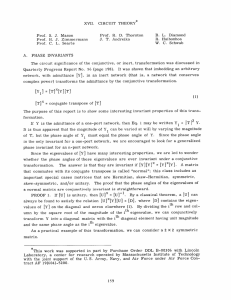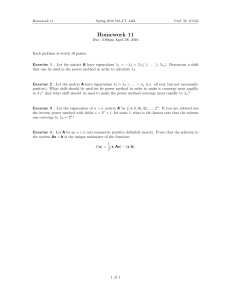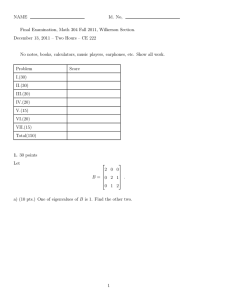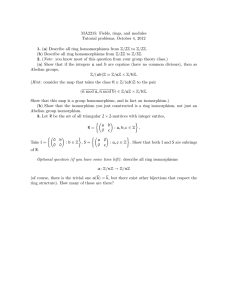1 Invariant ordering of surface groups and 3-manifolds which fibre over S
advertisement
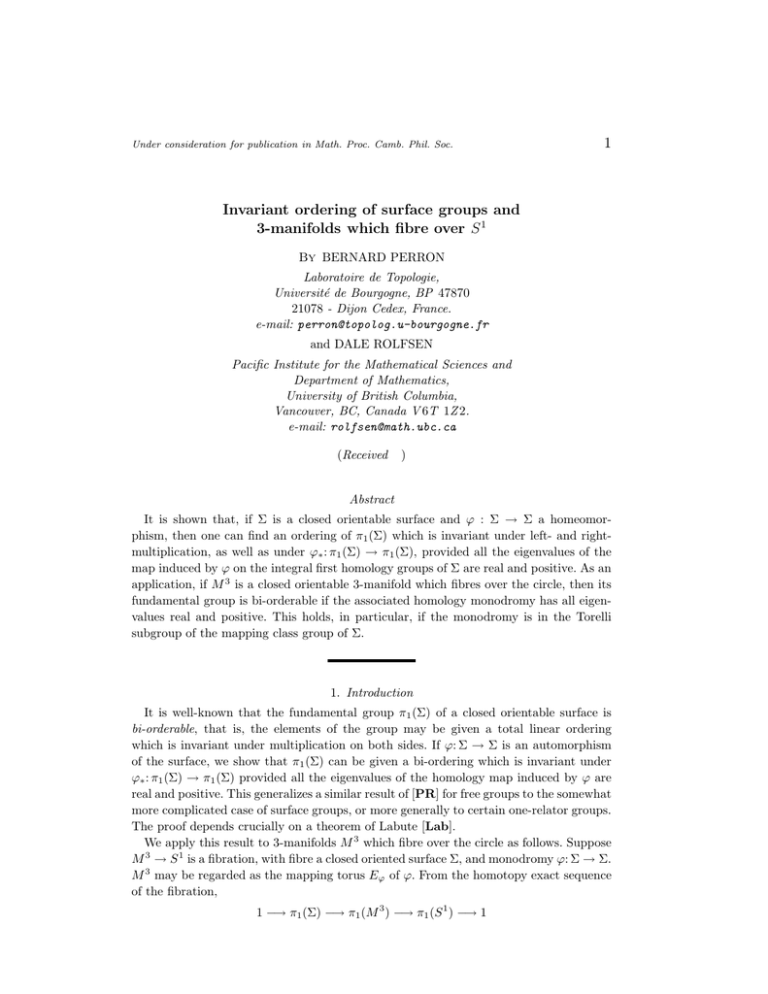
Under consideration for publication in Math. Proc. Camb. Phil. Soc.
1
Invariant ordering of surface groups and
3-manifolds which fibre over S 1
By BERNARD PERRON
Laboratoire de Topologie,
Université de Bourgogne, BP 47870
21078 - Dijon Cedex, France.
e-mail: perron@topolog.u-bourgogne.fr
and DALE ROLFSEN
Pacific Institute for the Mathematical Sciences and
Department of Mathematics,
University of British Columbia,
Vancouver, BC, Canada V 6T 1Z 2.
e-mail: rolfsen@math.ubc.ca
(Received
)
Abstract
It is shown that, if Σ is a closed orientable surface and ϕ : Σ → Σ a homeomorphism, then one can find an ordering of π1 (Σ) which is invariant under left- and rightmultiplication, as well as under ϕ∗ : π1 (Σ) → π1 (Σ), provided all the eigenvalues of the
map induced by ϕ on the integral first homology groups of Σ are real and positive. As an
application, if M 3 is a closed orientable 3-manifold which fibres over the circle, then its
fundamental group is bi-orderable if the associated homology monodromy has all eigenvalues real and positive. This holds, in particular, if the monodromy is in the Torelli
subgroup of the mapping class group of Σ.
1. Introduction
It is well-known that the fundamental group π1 (Σ) of a closed orientable surface is
bi-orderable, that is, the elements of the group may be given a total linear ordering
which is invariant under multiplication on both sides. If ϕ: Σ → Σ is an automorphism
of the surface, we show that π1 (Σ) can be given a bi-ordering which is invariant under
ϕ∗ : π1 (Σ) → π1 (Σ) provided all the eigenvalues of the homology map induced by ϕ are
real and positive. This generalizes a similar result of [PR] for free groups to the somewhat
more complicated case of surface groups, or more generally to certain one-relator groups.
The proof depends crucially on a theorem of Labute [Lab].
We apply this result to 3-manifolds M 3 which fibre over the circle as follows. Suppose
M 3 → S 1 is a fibration, with fibre a closed oriented surface Σ, and monodromy ϕ: Σ → Σ.
M 3 may be regarded as the mapping torus Eϕ of ϕ. From the homotopy exact sequence
of the fibration,
1 −→ π1 (Σ) −→ π1 (M 3 ) −→ π1 (S 1 ) −→ 1
Bernard Perron and Dale Rolfsen
2
and the orderability of π1 (Σ) and π1 (S 1 ) = Z, one can conclude (for any ϕ) that π1 (M 3 ) is
left-orderable (i.e. has an ordering invariant under left-multiplication). The fundamental
group of M 3 is an HNN extension of π1 (Σ), in other words, it is isomorphic to the
group π1 (Σ), with an extra generator t, subject to the relations t−1 xt = ϕ∗ (x), for all
generators x of π1 (Σ). To construct a bi-ordering for π1 (M 3 ), one needs a bi-ordering of
π1 (Σ) which is invariant under ϕ∗ . Thus π1 (M 3 ) is bi-orderable if all the eigenvalues of
the homology map induced by ϕ are real and positive.
2. The main result
Let G be a group. Define the descending central series of G by
G1 = G,
Gn = [G, Gn−1 ]
where [G, Gn−1 ] is the group generated by commutators [g, h] = ghg −1 h−1 , g ∈ G, h ∈
Gn−1 . We set Ln (G) = Gn /Gn+1 and gr(G) = ⊕∞
n=1 Ln (G).
Then Ln (G) are abelian groups and gr(F ) has a Lie algebra structure, by defining the
Lie product (u, v) 7→ [u, v] = uvu−1 v −1 ∈ Ln+m , for u ∈ Ln (G), v ∈ Lm (G).
Let F be a free group generated by x1 , · · · , xh and R ∈ F. Let e(R) = sup{n ; R ∈ Fn }.
We will assume the following condition:
(∗) e(R) > 1 and R is primitive, i.e. R is not a power modulo Fe(R)+1 .
Suppose G = F/hhRii is the corresponding single relator group. We make the following
additional hypothesis:
(∗∗)
∞
\
Gn = {1}.
n=1
Let Gab be the abelianization of G. By (∗), Gab is free abelian of rank h. More precisely
the canonical map F ab −→ Gab is an isomorphism.
Now let ϕ be an isomorphism of G, ϕab be the induced isomorphism on Gab . We
consider the hypothesis.
(∗ ∗ ∗) ϕab has all its eigenvalues real and positive (possibly with multiplicity).
Theorem 2·1. Let G be the single relator group F/hhRii satisfying hypothesis (∗) and
(∗∗), and suppose ϕ is an isomorphism of G satisfying (∗ ∗ ∗). Then there is a bi-ordering
of G which is invariant under ϕ.
This will be proved in Section 5.
Corollary 2·2. Assuming the hypotheses of Theorem 2·1, the HNN extension of G
by Z defined by ϕ is bi-orderable.
Proof If 1 → A → B → C → 1 is an exact sequence of groups, with A and C
bi-orderable, then B is biorderable provided conjugation of B upon A preserves a biordering of A. The ordering is defined by taking b1 < b2 in B if either b−1
1 b2 lies in A and
is greater than the identity there, or else its image is greater than the identity in C.
Remark : Hypotheses (∗) and (∗∗) are verified for G the fundamental group of a
closed orientable surface of genus g. Here h = 2g, F = hx1 , · · · , xg , y1 , · · · , yg i and R =
[x1 , y1 ] · · · [xg , yg ].
Invariant ordering of surface groups and 3-manifolds which fibre over S 13
Corollary 2·3. Let Σg be a closed oriented surface of genus g, ϕ a homeomorphism
of Σg such that the induced isomorphism on H1 (Σg ; Z) has all eigenvalues real and positive. Let Eϕ be the mapping torus of Σg associated to ϕ (this is a 3-manifold fibering
over S 1 ). Then the fundamental group of Eϕ is bi-orderable. This is true in particular if
ϕ belongs to the Torelli subgroup of the mapping class group of Σ g (that is, ϕ∗ = id at
the homological level).
Corollary 2·4. If M is a 3-manifold which fibres over the circle, with fibre a torus
(possibly with punctures), then π1 (M ) is virtually bi-orderable. In fact, it has a biorderable subgroup of index at most six.
Proof The monodromy matrix A is a 2 × 2 matrix with determinant 1 (if the fibre
is a punctured torus, the monodromy is the block sum of A with a number of identity
matrices). By considering the characteristic polynomial χA (t) = t2 − trace(A)t + 1, we
see that the eigenvalues of A are real if |trace(A)| > 2, and otherwise are roots of unity
of order 2, 3, 4 or 6. Accordingly the matrix Ap , with p = 1, 2, 3, 4 or 6, will have real
positive eigenvalues. This is the monodromy matrix of a p-fold cover of M .
1
3
2
5
4
Fig. 1. Curves on a genus 2 surface
Example: Let T1 , . . . , T5 denote the Dehn twists along the curves labelled 1, . . . , 5 on
the genus two surface pictured in Figure 1. Define ϕ = T1 T3 (T5 )2 T2−1 T4−1 . According to
[CB], p.79, the characteristic polynomial of ϕ∗ is t4 − 9t3 + 21t2 − 9t + 1. It is irreducible
over Z and has all it roots real and positive, so ϕ∗ satisfies (∗ ∗ ∗) and the corresponding
3-manifold Eϕ has bi-orderable fundamental group. Moreover, ϕ is pseudo-Anosov and
therefore Eϕ is hyperbolic.
Remark: It was mentioned in the introduction that for any homeomorphism ϕ : Σ →
Σ, the fibred manifold Eϕ has left-orderable fundamental group. We note that if ϕ is
periodic, even at the fundamental group level, then π1 (Eϕ ) cannot be bi-orderable. If
there were a bi-ordering on π1 (Eϕ ), which is the HNN extension determined by ϕ∗ :
π1 (Σ) → π1 (Σ), then the ordering would be invariant under conjugation and therefore
ϕ∗ -invariant. However, if ϕ∗ 6= 1 but ϕp∗ = 1 for some p > 1, we would have an element
x ∈ π1 (Σ) ⊂ π1 (Eϕ ) such that ϕ∗ (x) 6= x but ϕp∗ (x) = x. Suppose, without loss of
generality, x < ϕ∗ (x) in the bi-ordering. Then ϕ∗ (x) < ϕ2∗ (x), and by induction and
transitivity we conclude x < ϕp∗ (x) = x, a contradiction.
Bernard Perron and Dale Rolfsen
4
3. Review of some basic facts on Lie algebras
Let F be a free group. By ([Fox], section 4.5), z ∈ Fn if and only if z − 1 ∈ I n where
ε
I is the augmentation ideal of Z[F ] (I = Ker ZF −→Z). The map π(z) = z − 1 gives an
injective homomorphism:
π
Ln (F ) = Fn /Fn+1 −→ I n /I n+1 .
(1)
In fact if x, y ∈ Fn , then
π(xy) = xy − 1 = (x − 1) + (y − 1) + (x − 1)(y − 1) ≡ (x − 1) + (y − 1) mod I n+1 .
Lemma 3·1. π induces an injective homomorphism of Lie algebras:
(2)
π : L(F ) = ⊕∞
n=1 Ln (F )
−→
n
n+1
I = ⊕∞
n=1 I /I
where the Lie product on I is defined by [α, β] = αβ − βα.
Proof For x ∈ Fn , y ∈ Fm we have
π[x, y] = xyx−1 y −1 − 1
= (xy − yx)x−1 y −1
= (xy − yx) + (xy − yx)(x−1 y −1 − 1)
≡ [(x − 1)(y − 1) − (y − 1)(x − 1)] mod I n+m+1
≡ π(x)π(y) − π(y)π(x).
⊗n
Let H ⊗n = H ⊗ · · · ⊗ H (n times) where H = Fab and let H = ⊕∞
.
n=1 H
Lemma 3·2. a. For any positive integer n, the map
(3)
ψn : I n /I n+1 −→ H ⊗n
given by (xi1 − 1) · · · (xin − 1) −→ ai1 ⊗ · · · ⊗ ain is a homomorphism of abelian groups,
where xi is a generator of F and ai is the canonical image of xi in H = Fab .
b. The map ψ = ⊕ψn : I = ⊕I n /I n+1 −→ H = ⊕H ⊗n is an isomorphism of Lie
algebras, where the Lie structure of H is given by [α, β] = α ⊗ β − β ⊗ α, for α ∈ H ⊗n ,
β ∈ H ⊗m .
Proof The proof is routine (see [PR]).
4. Review of some results of Labute
Let R ∈ F = hx1 , · · · , xh i, e = sup{n ∈ N ; R ∈ Fn }. We suppose e > 1 and R
primitive. Let G = F/hhRii and R̄ be the class of R in Fe /Fe+1 ⊂ gr(F ). We of course
have a natural map gr(F ) −→ gr(G). Let I(R̄) be the ideal generated by R̄ in the Lie
algebra gr(F ) = ⊕Fn /Fn+1 .
That is, I(R̄) = {λ · R̄ + nR̄ ; λ ∈ gr(F ), n ∈ Z} where λ = λ1 ⊕ λ2 ⊕ · · · ⊕ λp ⊕ · · · ,
λi ∈ Li (F ) and λ · R̄ = ⊕i [λi , R].
Invariant ordering of surface groups and 3-manifolds which fibre over S 15
Theorem 4·1 (Labute [Lab]). With the above hypothesis on R,
1. Ln (G) = Gn /Gn+1 is a free Z-module of finite rank, for any positive integer n.
2. gr(G) ∼
= gr(F )/I(R̄).
Remark : Condition 2. means the following: Ln (G) is the quotient of Ln (F ) by the
equivalence relation ∼n defined as follows. Let x, y ∈ Fn , x̄, ȳ their classes in Fn /Fn+1 .
Then x̄ ∼n ȳ if and only if x̄ ∗ ȳ −1 ∈ I(R̄) (∗ is the abelian law in Fn /Fn+1 ). That is
x̄ ∗ ȳ −1 = λ · R̄ + pR̄, for some λ ∈ gr(F ), and p ∈ Z. Since x̄ ∗ ȳ −1 has degree n in
gr(F ), and R̄ has degree e this means:
(i) for n < e, Ln (G) = Ln (F ).
(ii) for n = e, Le (G) = Le (F )/hR̄i, where hR̄i is the subgroup generated by R̄.
(iii) for n > e, x̄ ∼ ȳ if and only if x̄ȳ −1 = [λn−e , R̄] for some λn−e ∈ Ln−e (F ).
Recall the following homomorphisms:
ψn
π
n
Ln (F )−→
I n /I n+1 −→ H ⊗n
ψ
π
L(F ) −→ I = ⊕I n /I n+1 −→ H = ⊕H ⊗n .
Denote by ρ0 the image of R̄ in H ⊗e by ψe ◦ πe .
Denote by J(ρ0 ) the image in H of the ideal I(R̄) by ψ ◦ π.
So J(ρ0 ) = {λ · ρ0 + nρ0 ; λ ∈ Im(ψ ◦ π), n ∈ Z} is an additive subgroup of H, but
no longer an ideal of H since ψ ◦ π is not surjective. The reason for considering J(ρ 0 )
instead of the ideal of H generated by ρ0 is that the induced map
(4)
ψ◦π
L(F )/I(R̄) −→ H/J(ρ0 )
continues to be injective. Of course H/J(ρ0 ) is no longer a Lie algebra. It induces an
injective homomorphism (of abelian groups)
(5)
Ln (G) = Ln (F )/ ∼n ,→ H ⊗n / ∼n
where H ⊗n / ∼n has the following meaning. This is the quotient of H ⊗n by the relation:
for x, y ∈ H ⊗n , x ∼n y if and only if x − y = λ · ρ0 + pρ0 = λ ⊗ ρ0 − ρ0 ⊗ λ + pρ0 for
λ ∈ Im(ψ ◦ π), p ∈ Z.
So if n < e, H ⊗n / ∼n = H ⊗n ,
If n = e, H ⊗e / ∼e = H ⊗e /hρ0 i,
If n > e, x ∼n y if and only if x − y = λ ⊗ ρ0 − ρ0 ⊗ λ for some λ ∈ Im(ψn−e ◦ πn−e ).
Now let ϕ be an isomorphism of G and ϕab the induced isomorphism of H = Gab ' Fab .
Let ϕ̃ : F −→ F be any homomorphism of the free group such that the following diagram
commutes:
(6)
F
↓
G
ϕ̃
−→ F
↓
ϕ
−→ G
Then ϕ
eab = ϕab . Denote by ϕ
fn the induced homomorphism
ϕ
fn : Fn /Fn+1 −→ Fn /Fn+1 .
In [PR] we proved that the following diagram is commutative:
Bernard Perron and Dale Rolfsen
6
Fn /Fn+1
(7)
ϕ
fn
ψn ◦πn
,→
↓
Fn /Fn+1
ψn ◦πn
,→
H ⊗n
↓ϕ
e⊗n
ab = ϕab ⊗ · · · ⊗ ϕab
H ⊗n
Lemma 4·2. ϕ⊗e
ab (ρ0 ) = ±ρ0 .
Proof Because of the commutativity of diagram (6), ϕ(R)
e
∈ hhRii, where hhRii denotes
the normal subgroup of F generated by R.
p
p
p
Y
Y
Y
Rεi = R(Σεi )
mod Fe+1 . By
[yi , Rεi ]Rεi ≡
yi Rεi yi−1 =
So ϕ(R)
e
=
i=1
i=1
i=1
Σεi
⊗e
commutativity of diagram (7) : ϕ⊗e
ab (ρ0 ) = ρ0 . Since ϕab is an isomorphism of free
abelian groups then Σεi = ±1.
⊗n
Corollary 4·3. ϕ⊗n
7−→ H ⊗n induces a map on the quotient H ⊗n / ∼n .
ab : H
Proof From the definition of ∼n (see (5)) it is sufficient to prove that
ϕ⊗n
ab (λn−e · ρ0 ) ∈ J(ρ0 ) for λn−e ∈ Im(ψ ◦ π):
⊗
ϕ⊗n
ab (λn−e · ρ0 ) = ϕab (λn−e ⊗ ρ0 − ρ0 ⊗ λn−e )
⊗
= ϕ⊗
ab (λn−e ) ⊗ (±ρ0 ) − (±ρ0 ) ⊗ ϕab (λn−e ).
By the commutativity of diagram (7), ϕ⊗
ab (λn−e ) ∈ Im (ψ ◦ π).
So diagram (7) gives rise to a commutative diagram:
Gn /Gn+1
(8)
,→ H ⊗n / ∼n
↓ ϕ⊗n
ab
ϕn ↓
Gn /Gn+1
,→ H ⊗n / ∼n
where the vertical arrows are isomorphisms and horizontal ones are injective.
Tensoring diagram (8) by R, we get a commutative diagram
(Gn /Gn+1 ) ⊗ R ,→ (H ⊗n / ∼n ) ⊗ R
(9)
↓ ϕ⊗n
ab ⊗ idR
ϕn ⊗ idR ↓
(Gn /Gn+1 ) ⊗ R ,→ (H ⊗n / ∼n ) ⊗ R
where the horizontal arrows are still injective.
Denote by Vn (resp. ϕ̂n ) the R-vector space (H ⊗n / ∼n ) ⊗ R (resp. ϕ⊗n
ab ⊗ idR ). Since
Gn /Gn+1 is torsion-free, by Labute’s theorem we get a commutative diagram, where the
horizontal arrows are injective:
(10)
Gn /Gn+1
ϕn ↓
Gn /Gn+1
,→
,→
Vn
↓ ϕ̂n
Vn
Invariant ordering of surface groups and 3-manifolds which fibre over S 17
Lemma 4·4. If ϕab : H −→ H has only real positive eigenvalues, the same holds for
ϕ̂n for any n.
Proof Tensoring the following diagram by R:
H ⊗n
−−→ H ⊗n / ∼n
↓ ϕ⊗n
ab
H ⊗n
↓ ϕ⊗n
ab
−−→ H ⊗n / ∼n
we get a commutative diagram of vector spaces with exact rows, where E denotes the
kernel, and the map E → E is the restriction of ϕ⊗n
ab ⊗ R:
0 −→ E
↓
0 −→ E
−→ H ⊗n ⊗ R
−→
↓ ϕ⊗n
ab ⊗ R
−→ H ⊗n ⊗ R
Vn
−→ 0
↓ ϕ̂n
−→
Vn
−→ 0
The matrix of ϕ⊗n
ab ⊗ R has the following form in a suitable basis :
α ?
0 β
where α is the matrix of ϕ⊗n
ab ⊗ R restricted to E and β the matrix of ϕ̂n . The eigenvalues
of ϕ⊗n
⊗
R
are
products
of
the eigenvalues of ϕab ⊗ R and therefore all real and positive.
ab
So β has only real positive eigenvalues.
5. Proof of Theorem 2·1
Assuming that G and ϕ: G → G satisfy the hypotheses of Theorem 2·1, we need to
construct an ordering of the elements of G which is invariant under multiplication on
both sides, and also invariant under the map ϕ. We may proceed exactly as in section 4
of [PR], which we outline here for the reader’s convenience.
Go back to diagram (10), where the vector space isomorphism ϕ̂n has all its eigenvalues
real and positive. By standard linear algebra, there exists a basis v1 , · · · , vk for Vn with
respect to which the matrix for ϕ̂ is upper triangular and has its (positive) eigenvalues
λ1 , · · · , λk on the diagonal. We order the vectors in Vn by reverse lexicographical ordering,
using their coordinates relative to the basis v1 , · · · , vk . Thus if x = x1 v1 + · · · + xk vk and
y = y1 v1 + · · · + yk vk are distinct vectors in Vn , we define x < y if and only xi < yi (in
the usual ordering of R), at the last i for which the coordinates differ. It is routine to
check that this ordering of Vn is invariant under vector addition and also that x < y if
and only if ϕ̂(x) < ϕ̂(y). Restricting this ordering to the abelian group Gn /Gn+1 defines
an ordering which is invariant under the isomorphism ϕn .
We now have ϕn -invariant orderings of the lower central quotients Gn /Gn+1 , for each
n ∈ Z, and use this to define a ϕ-invariant bi-order on G using a well-known technique
for ordering groups which are residually nilpotent and have torsion-free lower central
quotients. Namely, let g, h ∈ G and consider n = n(g, h) = n(h, g) to be the greatest
integer such that g −1 h belongs to Gn . Then define g < h if the coset of g −1 h is greater
than the identity in the ordering of Gn /Gn+1 and h < g otherwise. It is routine to check
8
Bernard Perron and Dale Rolfsen
that this defines a bi-ordering of G, and it is invariant under ϕ because the orderings of
Gn /Gn+1 are invariant under ϕn .
REFERENCES
[CB] A. Casson, S. Bleiler : Automorphisms of surfaces after Nielsen and Thurston. London
Math. Soc. Student Texts 9 (1988).
[Fox] R. H. Fox, Free differential calculus I. Annals of Math 57 (1953), 547–560.
[Lab] J.-P. Labute, On the descending central series of groups with a single defining relation.
Journal of Algebra 14 (1970), 16–20.
[PR] B. Perron, D. Rolfsen, On orderability of fibred knot groups, Math. Proc. Camb. Phil.
Soc. 135(2003), 135–147.


